Business in Practice Report: Company Types, Structures, and Factors
VerifiedAdded on 2022/12/27
|10
|2771
|47
Report
AI Summary
This report provides a detailed analysis of various company types, including micro, small, medium, and large businesses, exploring their definitions, characteristics, and examples. It further examines different business structures, ranging from sole traders to cooperatives and Limited Liability Partnerships, highlighting their key features and operational aspects. The report delves into the impact of organizational structures on business productivity, discussing functional and divisional structures, and emphasizing the importance of innovation and communication. Moreover, it utilizes PESTLE analysis to evaluate the external factors—political, economic, social, technological, legal, and environmental—that influence business performance, using Unilever as a case study. The report concludes by summarizing the key findings and implications for business strategy and decision-making.

Business in practices
Paraphrase This Document
Need a fresh take? Get an instant paraphrase of this document with our AI Paraphraser
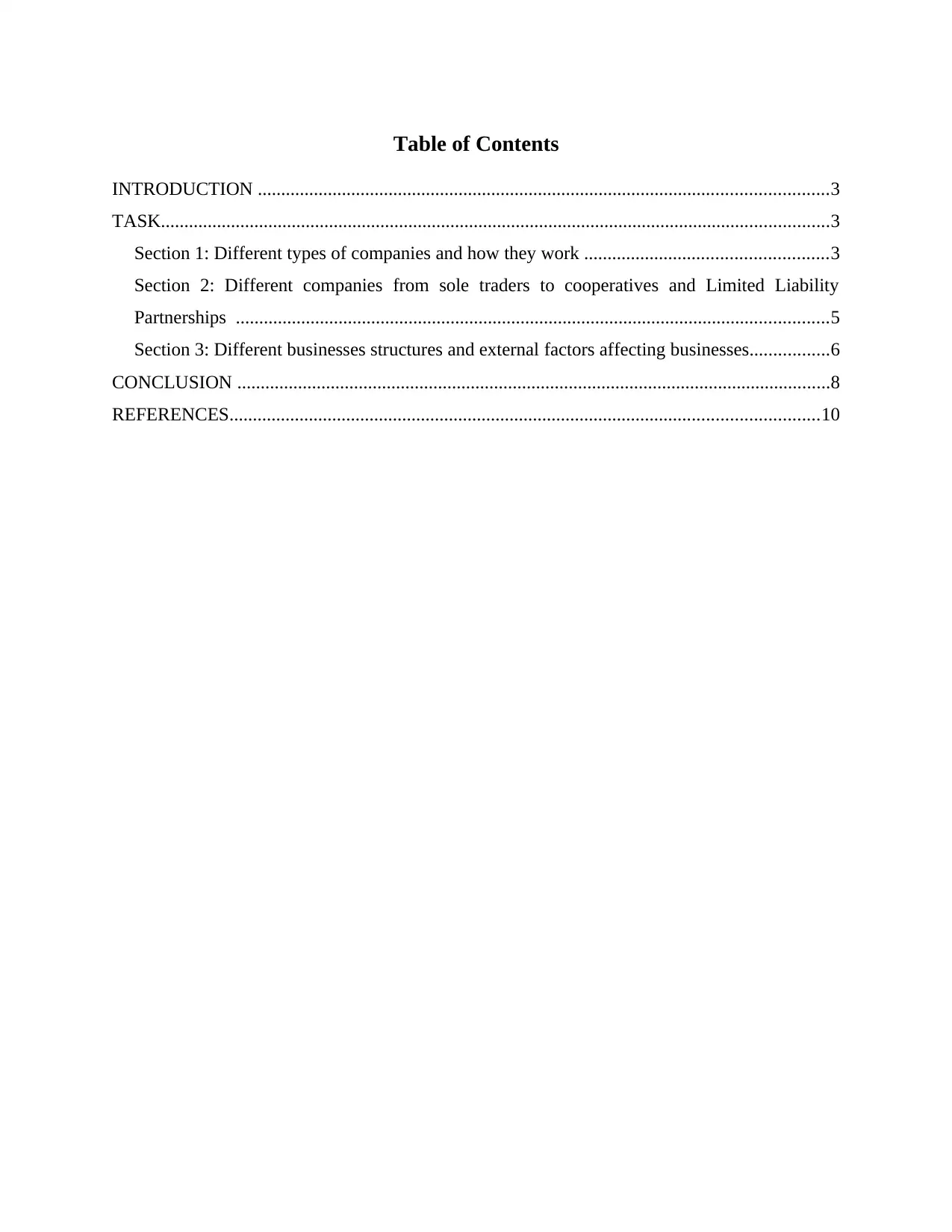
Table of Contents
INTRODUCTION ..........................................................................................................................3
TASK...............................................................................................................................................3
Section 1: Different types of companies and how they work ....................................................3
Section 2: Different companies from sole traders to cooperatives and Limited Liability
Partnerships ...............................................................................................................................5
Section 3: Different businesses structures and external factors affecting businesses.................6
CONCLUSION ...............................................................................................................................8
REFERENCES..............................................................................................................................10
INTRODUCTION ..........................................................................................................................3
TASK...............................................................................................................................................3
Section 1: Different types of companies and how they work ....................................................3
Section 2: Different companies from sole traders to cooperatives and Limited Liability
Partnerships ...............................................................................................................................5
Section 3: Different businesses structures and external factors affecting businesses.................6
CONCLUSION ...............................................................................................................................8
REFERENCES..............................................................................................................................10
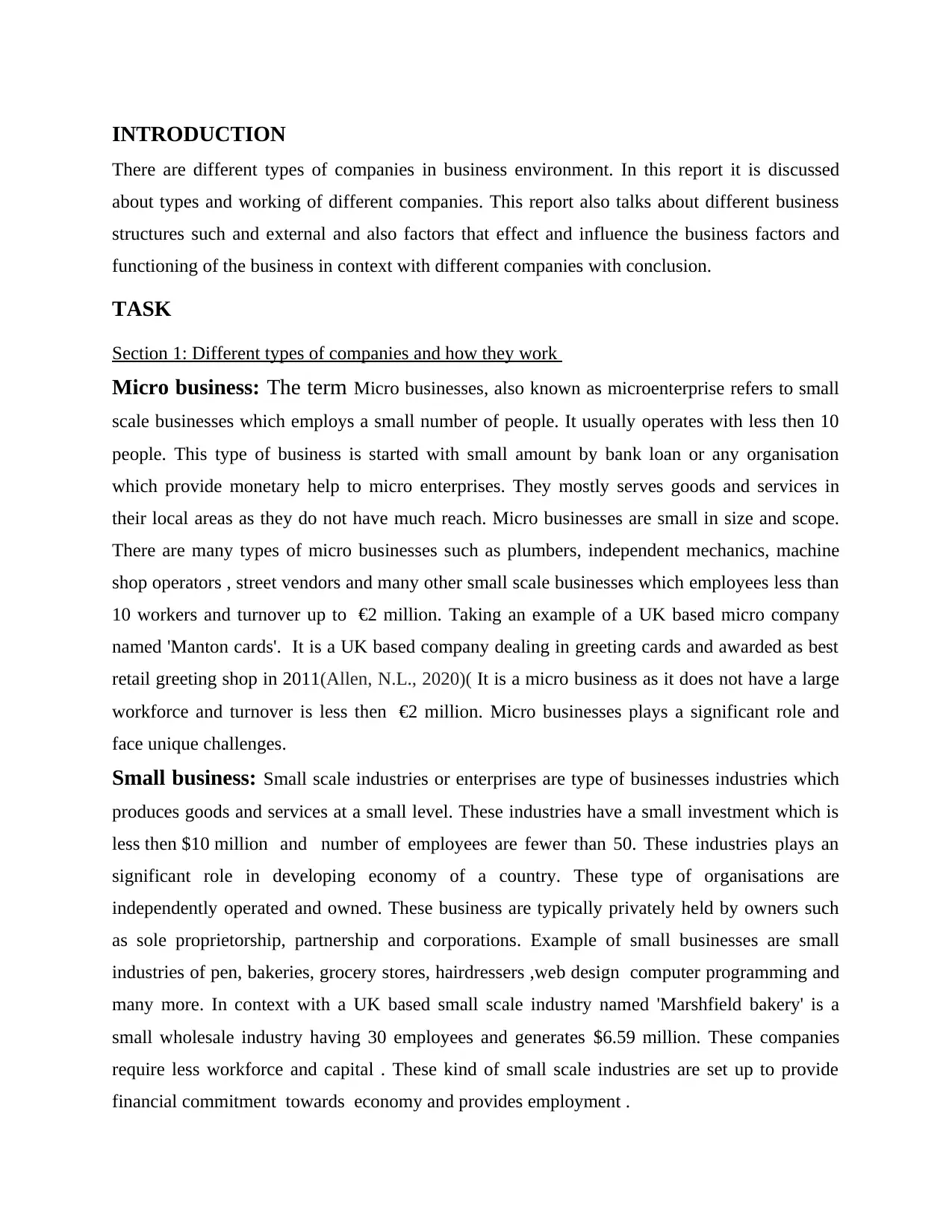
INTRODUCTION
There are different types of companies in business environment. In this report it is discussed
about types and working of different companies. This report also talks about different business
structures such and external and also factors that effect and influence the business factors and
functioning of the business in context with different companies with conclusion.
TASK
Section 1: Different types of companies and how they work
Micro business: The term Micro businesses, also known as microenterprise refers to small
scale businesses which employs a small number of people. It usually operates with less then 10
people. This type of business is started with small amount by bank loan or any organisation
which provide monetary help to micro enterprises. They mostly serves goods and services in
their local areas as they do not have much reach. Micro businesses are small in size and scope.
There are many types of micro businesses such as plumbers, independent mechanics, machine
shop operators , street vendors and many other small scale businesses which employees less than
10 workers and turnover up to €2 million. Taking an example of a UK based micro company
named 'Manton cards'. It is a UK based company dealing in greeting cards and awarded as best
retail greeting shop in 2011(Allen, N.L., 2020)( It is a micro business as it does not have a large
workforce and turnover is less then €2 million. Micro businesses plays a significant role and
face unique challenges.
Small business: Small scale industries or enterprises are type of businesses industries which
produces goods and services at a small level. These industries have a small investment which is
less then $10 million and number of employees are fewer than 50. These industries plays an
significant role in developing economy of a country. These type of organisations are
independently operated and owned. These business are typically privately held by owners such
as sole proprietorship, partnership and corporations. Example of small businesses are small
industries of pen, bakeries, grocery stores, hairdressers ,web design computer programming and
many more. In context with a UK based small scale industry named 'Marshfield bakery' is a
small wholesale industry having 30 employees and generates $6.59 million. These companies
require less workforce and capital . These kind of small scale industries are set up to provide
financial commitment towards economy and provides employment .
There are different types of companies in business environment. In this report it is discussed
about types and working of different companies. This report also talks about different business
structures such and external and also factors that effect and influence the business factors and
functioning of the business in context with different companies with conclusion.
TASK
Section 1: Different types of companies and how they work
Micro business: The term Micro businesses, also known as microenterprise refers to small
scale businesses which employs a small number of people. It usually operates with less then 10
people. This type of business is started with small amount by bank loan or any organisation
which provide monetary help to micro enterprises. They mostly serves goods and services in
their local areas as they do not have much reach. Micro businesses are small in size and scope.
There are many types of micro businesses such as plumbers, independent mechanics, machine
shop operators , street vendors and many other small scale businesses which employees less than
10 workers and turnover up to €2 million. Taking an example of a UK based micro company
named 'Manton cards'. It is a UK based company dealing in greeting cards and awarded as best
retail greeting shop in 2011(Allen, N.L., 2020)( It is a micro business as it does not have a large
workforce and turnover is less then €2 million. Micro businesses plays a significant role and
face unique challenges.
Small business: Small scale industries or enterprises are type of businesses industries which
produces goods and services at a small level. These industries have a small investment which is
less then $10 million and number of employees are fewer than 50. These industries plays an
significant role in developing economy of a country. These type of organisations are
independently operated and owned. These business are typically privately held by owners such
as sole proprietorship, partnership and corporations. Example of small businesses are small
industries of pen, bakeries, grocery stores, hairdressers ,web design computer programming and
many more. In context with a UK based small scale industry named 'Marshfield bakery' is a
small wholesale industry having 30 employees and generates $6.59 million. These companies
require less workforce and capital . These kind of small scale industries are set up to provide
financial commitment towards economy and provides employment .
⊘ This is a preview!⊘
Do you want full access?
Subscribe today to unlock all pages.

Trusted by 1+ million students worldwide
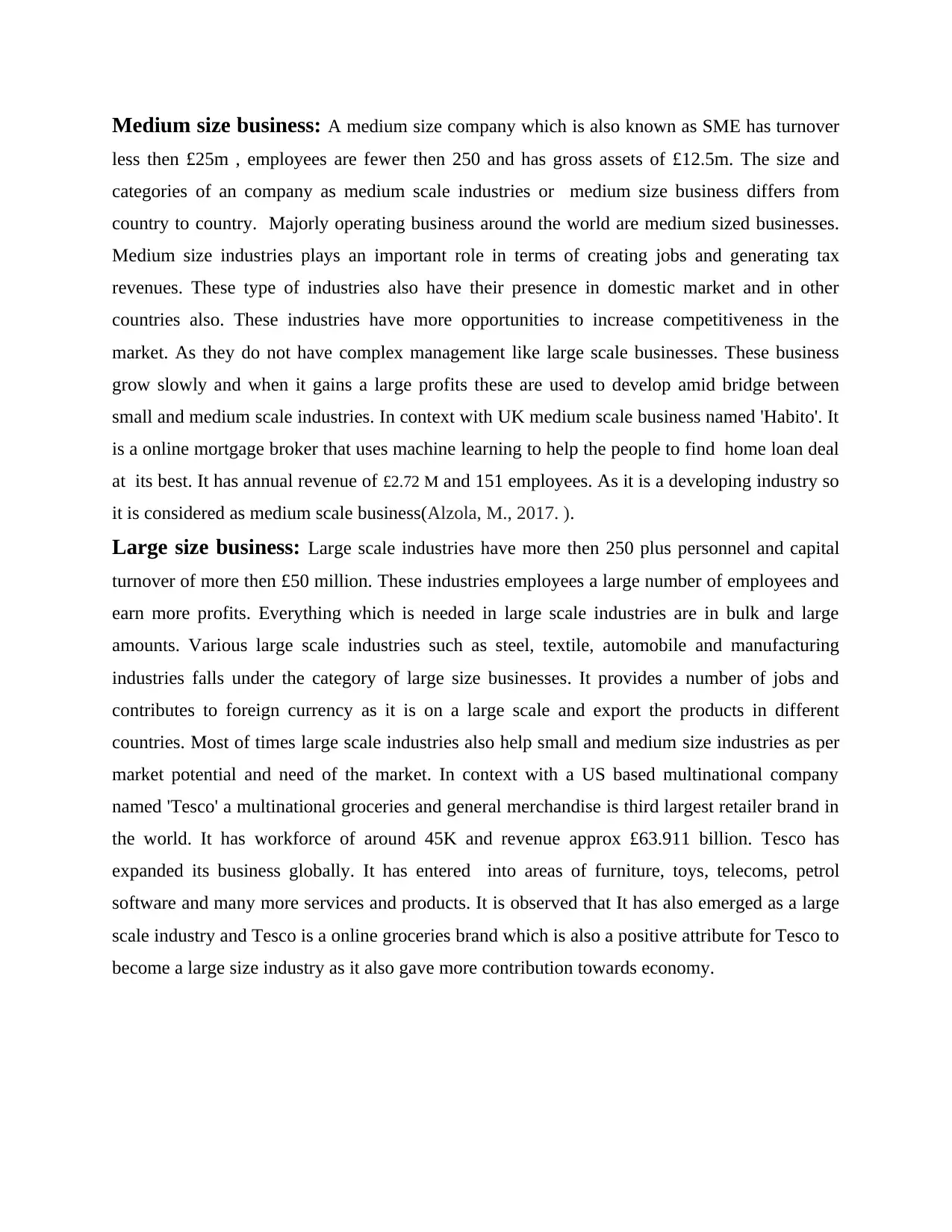
Medium size business: A medium size company which is also known as SME has turnover
less then £25m , employees are fewer then 250 and has gross assets of £12.5m. The size and
categories of an company as medium scale industries or medium size business differs from
country to country. Majorly operating business around the world are medium sized businesses.
Medium size industries plays an important role in terms of creating jobs and generating tax
revenues. These type of industries also have their presence in domestic market and in other
countries also. These industries have more opportunities to increase competitiveness in the
market. As they do not have complex management like large scale businesses. These business
grow slowly and when it gains a large profits these are used to develop amid bridge between
small and medium scale industries. In context with UK medium scale business named 'Habito'. It
is a online mortgage broker that uses machine learning to help the people to find home loan deal
at its best. It has annual revenue of £2.72 M and 151 employees. As it is a developing industry so
it is considered as medium scale business(Alzola, M., 2017. ).
Large size business: Large scale industries have more then 250 plus personnel and capital
turnover of more then £50 million. These industries employees a large number of employees and
earn more profits. Everything which is needed in large scale industries are in bulk and large
amounts. Various large scale industries such as steel, textile, automobile and manufacturing
industries falls under the category of large size businesses. It provides a number of jobs and
contributes to foreign currency as it is on a large scale and export the products in different
countries. Most of times large scale industries also help small and medium size industries as per
market potential and need of the market. In context with a US based multinational company
named 'Tesco' a multinational groceries and general merchandise is third largest retailer brand in
the world. It has workforce of around 45K and revenue approx £63.911 billion. Tesco has
expanded its business globally. It has entered into areas of furniture, toys, telecoms, petrol
software and many more services and products. It is observed that It has also emerged as a large
scale industry and Tesco is a online groceries brand which is also a positive attribute for Tesco to
become a large size industry as it also gave more contribution towards economy.
less then £25m , employees are fewer then 250 and has gross assets of £12.5m. The size and
categories of an company as medium scale industries or medium size business differs from
country to country. Majorly operating business around the world are medium sized businesses.
Medium size industries plays an important role in terms of creating jobs and generating tax
revenues. These type of industries also have their presence in domestic market and in other
countries also. These industries have more opportunities to increase competitiveness in the
market. As they do not have complex management like large scale businesses. These business
grow slowly and when it gains a large profits these are used to develop amid bridge between
small and medium scale industries. In context with UK medium scale business named 'Habito'. It
is a online mortgage broker that uses machine learning to help the people to find home loan deal
at its best. It has annual revenue of £2.72 M and 151 employees. As it is a developing industry so
it is considered as medium scale business(Alzola, M., 2017. ).
Large size business: Large scale industries have more then 250 plus personnel and capital
turnover of more then £50 million. These industries employees a large number of employees and
earn more profits. Everything which is needed in large scale industries are in bulk and large
amounts. Various large scale industries such as steel, textile, automobile and manufacturing
industries falls under the category of large size businesses. It provides a number of jobs and
contributes to foreign currency as it is on a large scale and export the products in different
countries. Most of times large scale industries also help small and medium size industries as per
market potential and need of the market. In context with a US based multinational company
named 'Tesco' a multinational groceries and general merchandise is third largest retailer brand in
the world. It has workforce of around 45K and revenue approx £63.911 billion. Tesco has
expanded its business globally. It has entered into areas of furniture, toys, telecoms, petrol
software and many more services and products. It is observed that It has also emerged as a large
scale industry and Tesco is a online groceries brand which is also a positive attribute for Tesco to
become a large size industry as it also gave more contribution towards economy.
Paraphrase This Document
Need a fresh take? Get an instant paraphrase of this document with our AI Paraphraser

Section 2: Different companies from sole traders to cooperatives and Limited Liability
Partnerships
Sole trader business: Sole trader is a self employed person who runs and owns their
business as an individual who are responsible for its business assets and debts by its own. It is a
set up by a single individual. As a sole trader a person has complete control over business.
Owner is responsible for liabilities of the company and liability is unlimited in the case of sole
proprietorship. Legal formalities are very less as the business is owned and run by a single
person only. It is one of the easiest and cheap business which can be established easily and legal
formalities are also less. In this type of business an individual is responsible for its own capital
and assumes all the risks of ownership. It also includes home based businesses which is operated
by sole proprietor(Boone and et. al 2019)(Borges and et.al 2017). Some of examples of sole
proprietorship are running a book keeping business,computer repair services, financial planners,
freelancer businesses and many more.
Partnership:Partnership can be general partnership or limited partnership. In general partnership
liability of every partner is unlimited as in the case if partners suffers the losses every partner is
responsible to pay the losses and for that personal assets of the partners can be used . It means
every partner is responsible for the conduct of every partner(Warwick and et.al2017) . But in the
case of limited liability partnership every partner is not responsible for the actions of other
partners. In General partnership any legal formalities are not required as it is collection of people
who agrees to start a business and every partner have unlimited liability. But in case of limited
liability partnership certain documents such as financial statements, restrictions, names of
partners and motive of partnership is mentioned. It is a complex process and for formation of
limited liability partnership. Some examples of partnership firms are GoPro and Red bull, BMW
and Louis Vuitton, Uber and Spotify ,Apple and Mastercard etc. It is a kind of formal
agreement wgere two or more people agrees to distribute responsibilities and also shares profit
and losses suffered through businesses.
Limited liability company:Limited liability companies is formal partnership in which members
of the company are not liable personally for the debts of the company. The company can be
started by two or more members but at least two members are mandatory to start a company. It
is formed legally by registering the company at registrar office. It must have minimum one
Partnerships
Sole trader business: Sole trader is a self employed person who runs and owns their
business as an individual who are responsible for its business assets and debts by its own. It is a
set up by a single individual. As a sole trader a person has complete control over business.
Owner is responsible for liabilities of the company and liability is unlimited in the case of sole
proprietorship. Legal formalities are very less as the business is owned and run by a single
person only. It is one of the easiest and cheap business which can be established easily and legal
formalities are also less. In this type of business an individual is responsible for its own capital
and assumes all the risks of ownership. It also includes home based businesses which is operated
by sole proprietor(Boone and et. al 2019)(Borges and et.al 2017). Some of examples of sole
proprietorship are running a book keeping business,computer repair services, financial planners,
freelancer businesses and many more.
Partnership:Partnership can be general partnership or limited partnership. In general partnership
liability of every partner is unlimited as in the case if partners suffers the losses every partner is
responsible to pay the losses and for that personal assets of the partners can be used . It means
every partner is responsible for the conduct of every partner(Warwick and et.al2017) . But in the
case of limited liability partnership every partner is not responsible for the actions of other
partners. In General partnership any legal formalities are not required as it is collection of people
who agrees to start a business and every partner have unlimited liability. But in case of limited
liability partnership certain documents such as financial statements, restrictions, names of
partners and motive of partnership is mentioned. It is a complex process and for formation of
limited liability partnership. Some examples of partnership firms are GoPro and Red bull, BMW
and Louis Vuitton, Uber and Spotify ,Apple and Mastercard etc. It is a kind of formal
agreement wgere two or more people agrees to distribute responsibilities and also shares profit
and losses suffered through businesses.
Limited liability company:Limited liability companies is formal partnership in which members
of the company are not liable personally for the debts of the company. The company can be
started by two or more members but at least two members are mandatory to start a company. It
is formed legally by registering the company at registrar office. It must have minimum one
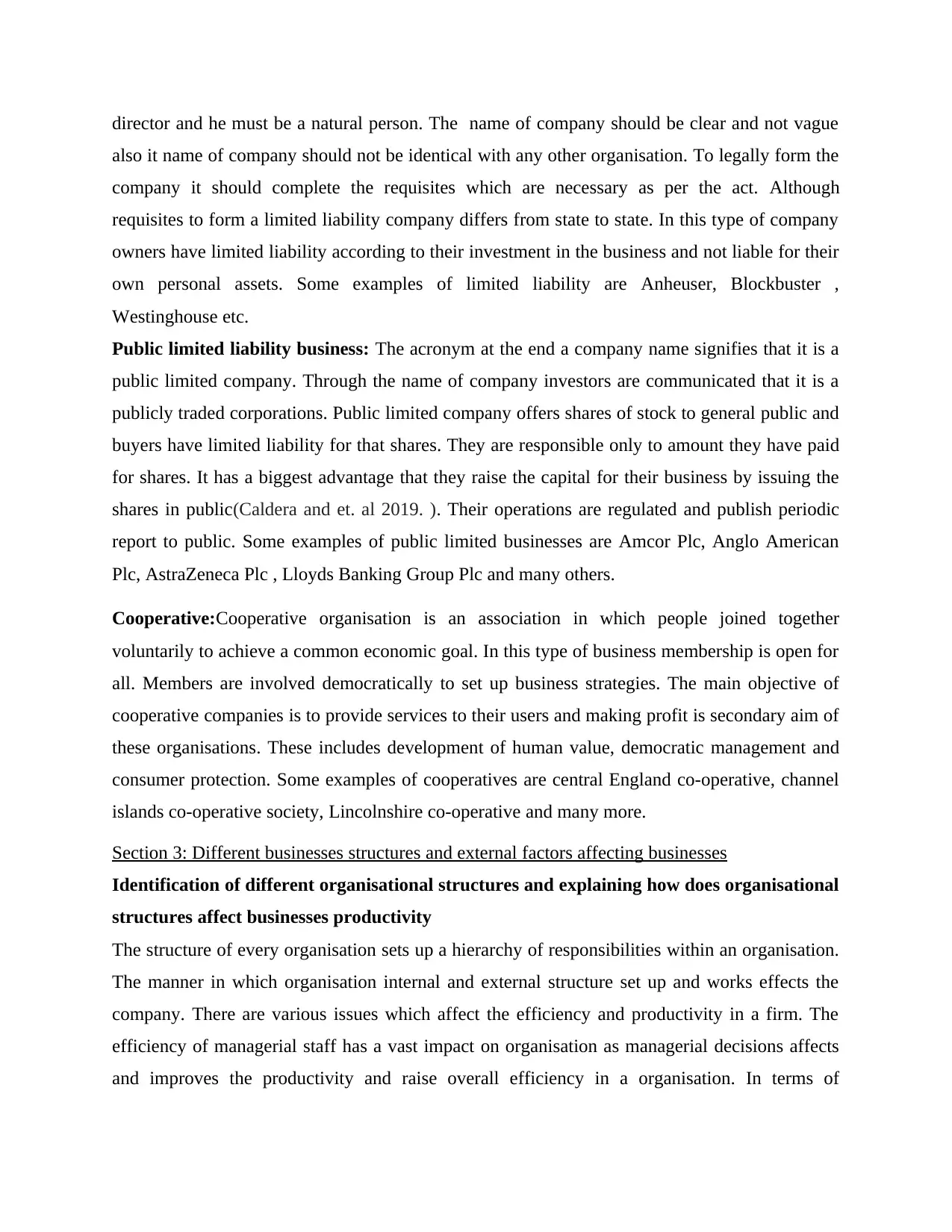
director and he must be a natural person. The name of company should be clear and not vague
also it name of company should not be identical with any other organisation. To legally form the
company it should complete the requisites which are necessary as per the act. Although
requisites to form a limited liability company differs from state to state. In this type of company
owners have limited liability according to their investment in the business and not liable for their
own personal assets. Some examples of limited liability are Anheuser, Blockbuster ,
Westinghouse etc.
Public limited liability business: The acronym at the end a company name signifies that it is a
public limited company. Through the name of company investors are communicated that it is a
publicly traded corporations. Public limited company offers shares of stock to general public and
buyers have limited liability for that shares. They are responsible only to amount they have paid
for shares. It has a biggest advantage that they raise the capital for their business by issuing the
shares in public(Caldera and et. al 2019. ). Their operations are regulated and publish periodic
report to public. Some examples of public limited businesses are Amcor Plc, Anglo American
Plc, AstraZeneca Plc , Lloyds Banking Group Plc and many others.
Cooperative:Cooperative organisation is an association in which people joined together
voluntarily to achieve a common economic goal. In this type of business membership is open for
all. Members are involved democratically to set up business strategies. The main objective of
cooperative companies is to provide services to their users and making profit is secondary aim of
these organisations. These includes development of human value, democratic management and
consumer protection. Some examples of cooperatives are central England co-operative, channel
islands co-operative society, Lincolnshire co-operative and many more.
Section 3: Different businesses structures and external factors affecting businesses
Identification of different organisational structures and explaining how does organisational
structures affect businesses productivity
The structure of every organisation sets up a hierarchy of responsibilities within an organisation.
The manner in which organisation internal and external structure set up and works effects the
company. There are various issues which affect the efficiency and productivity in a firm. The
efficiency of managerial staff has a vast impact on organisation as managerial decisions affects
and improves the productivity and raise overall efficiency in a organisation. In terms of
also it name of company should not be identical with any other organisation. To legally form the
company it should complete the requisites which are necessary as per the act. Although
requisites to form a limited liability company differs from state to state. In this type of company
owners have limited liability according to their investment in the business and not liable for their
own personal assets. Some examples of limited liability are Anheuser, Blockbuster ,
Westinghouse etc.
Public limited liability business: The acronym at the end a company name signifies that it is a
public limited company. Through the name of company investors are communicated that it is a
publicly traded corporations. Public limited company offers shares of stock to general public and
buyers have limited liability for that shares. They are responsible only to amount they have paid
for shares. It has a biggest advantage that they raise the capital for their business by issuing the
shares in public(Caldera and et. al 2019. ). Their operations are regulated and publish periodic
report to public. Some examples of public limited businesses are Amcor Plc, Anglo American
Plc, AstraZeneca Plc , Lloyds Banking Group Plc and many others.
Cooperative:Cooperative organisation is an association in which people joined together
voluntarily to achieve a common economic goal. In this type of business membership is open for
all. Members are involved democratically to set up business strategies. The main objective of
cooperative companies is to provide services to their users and making profit is secondary aim of
these organisations. These includes development of human value, democratic management and
consumer protection. Some examples of cooperatives are central England co-operative, channel
islands co-operative society, Lincolnshire co-operative and many more.
Section 3: Different businesses structures and external factors affecting businesses
Identification of different organisational structures and explaining how does organisational
structures affect businesses productivity
The structure of every organisation sets up a hierarchy of responsibilities within an organisation.
The manner in which organisation internal and external structure set up and works effects the
company. There are various issues which affect the efficiency and productivity in a firm. The
efficiency of managerial staff has a vast impact on organisation as managerial decisions affects
and improves the productivity and raise overall efficiency in a organisation. In terms of
⊘ This is a preview!⊘
Do you want full access?
Subscribe today to unlock all pages.

Trusted by 1+ million students worldwide
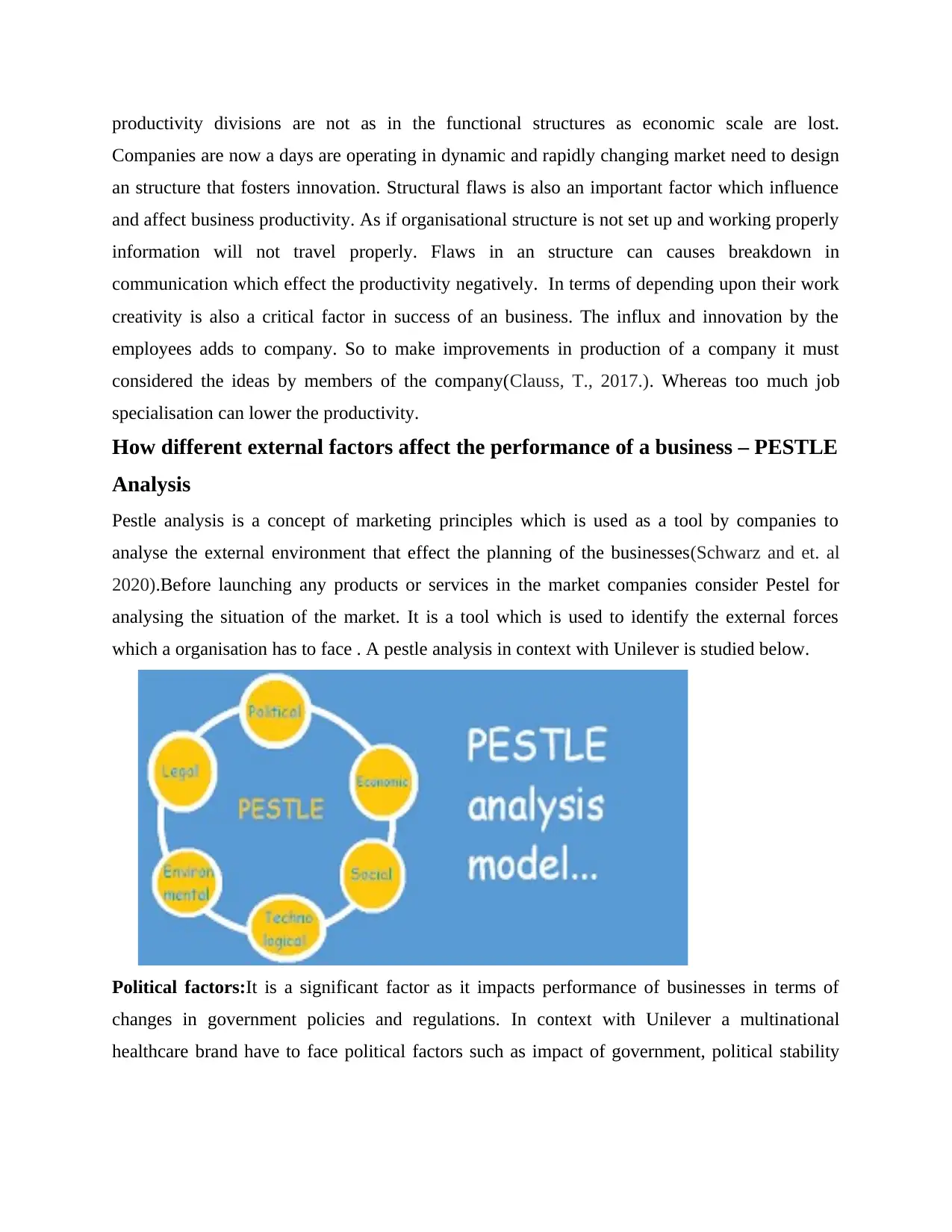
productivity divisions are not as in the functional structures as economic scale are lost.
Companies are now a days are operating in dynamic and rapidly changing market need to design
an structure that fosters innovation. Structural flaws is also an important factor which influence
and affect business productivity. As if organisational structure is not set up and working properly
information will not travel properly. Flaws in an structure can causes breakdown in
communication which effect the productivity negatively. In terms of depending upon their work
creativity is also a critical factor in success of an business. The influx and innovation by the
employees adds to company. So to make improvements in production of a company it must
considered the ideas by members of the company(Clauss, T., 2017.). Whereas too much job
specialisation can lower the productivity.
How different external factors affect the performance of a business – PESTLE
Analysis
Pestle analysis is a concept of marketing principles which is used as a tool by companies to
analyse the external environment that effect the planning of the businesses(Schwarz and et. al
2020).Before launching any products or services in the market companies consider Pestel for
analysing the situation of the market. It is a tool which is used to identify the external forces
which a organisation has to face . A pestle analysis in context with Unilever is studied below.
Political factors:It is a significant factor as it impacts performance of businesses in terms of
changes in government policies and regulations. In context with Unilever a multinational
healthcare brand have to face political factors such as impact of government, political stability
Companies are now a days are operating in dynamic and rapidly changing market need to design
an structure that fosters innovation. Structural flaws is also an important factor which influence
and affect business productivity. As if organisational structure is not set up and working properly
information will not travel properly. Flaws in an structure can causes breakdown in
communication which effect the productivity negatively. In terms of depending upon their work
creativity is also a critical factor in success of an business. The influx and innovation by the
employees adds to company. So to make improvements in production of a company it must
considered the ideas by members of the company(Clauss, T., 2017.). Whereas too much job
specialisation can lower the productivity.
How different external factors affect the performance of a business – PESTLE
Analysis
Pestle analysis is a concept of marketing principles which is used as a tool by companies to
analyse the external environment that effect the planning of the businesses(Schwarz and et. al
2020).Before launching any products or services in the market companies consider Pestel for
analysing the situation of the market. It is a tool which is used to identify the external forces
which a organisation has to face . A pestle analysis in context with Unilever is studied below.
Political factors:It is a significant factor as it impacts performance of businesses in terms of
changes in government policies and regulations. In context with Unilever a multinational
healthcare brand have to face political factors such as impact of government, political stability
Paraphrase This Document
Need a fresh take? Get an instant paraphrase of this document with our AI Paraphraser

and opportunities for free trade relations by which Unilever can grow and expand its business in
more countries(Keiningham and et.al 2020. )
Economic factors:It is also a significant factor which impacts on development of a business if
the economic condition of a country is stable there are more opportunities for a company to
grow. In context of Unilever increasing wages in developing countries is an opportunity as well
as a threat for Unilever as it increases the costs for the countries(Lind and et.al 2017). .
Developing countries are nowadays growing. Moreover economic stability of the country is a
opportunity for Unilever for global growth.
Social factors:These factors refers to demographics and cultural factors which is in trend. In
association with Unilever there are many opportunities to increase their business. As it is a health
care company and people have became health conscious nowadays which is the biggest social
opportunity for Unilever to grow.
Technological factors: This is a significant factor for development of countries with increasing
e- commerce practices and digitalization. Companies have great opportunities to increase their
business globally. In context with Unilever automation and digitalization is an opportunity to
support its customers.
Environmental factors:Consumers have become more aware and conscious towards adopting
well environmental practices. In context with Unilever increasing efforts on sustainability and
rising interest in business environment has became an opportunity.
Legal factors: It concerns with factors related to government policies and state laws in the
market. In context with Unilever it has opportunity to enhance its corporate image by making
strategies for organisation of corporate social responsibility and strengthening consumer law
rights.
CONCLUSION
From the above discussion it is concluded that this report is helpful in understanding different
types of companies such as partnership, sole proprietor, limited liability company and
cooperative. In addition with different companies and different types of business structures and
external factors affecting the business explained with Pestle analysis in context with Unilever.
The divisional and functional business structure is explained which affects the productivity in a
organisation.
more countries(Keiningham and et.al 2020. )
Economic factors:It is also a significant factor which impacts on development of a business if
the economic condition of a country is stable there are more opportunities for a company to
grow. In context of Unilever increasing wages in developing countries is an opportunity as well
as a threat for Unilever as it increases the costs for the countries(Lind and et.al 2017). .
Developing countries are nowadays growing. Moreover economic stability of the country is a
opportunity for Unilever for global growth.
Social factors:These factors refers to demographics and cultural factors which is in trend. In
association with Unilever there are many opportunities to increase their business. As it is a health
care company and people have became health conscious nowadays which is the biggest social
opportunity for Unilever to grow.
Technological factors: This is a significant factor for development of countries with increasing
e- commerce practices and digitalization. Companies have great opportunities to increase their
business globally. In context with Unilever automation and digitalization is an opportunity to
support its customers.
Environmental factors:Consumers have become more aware and conscious towards adopting
well environmental practices. In context with Unilever increasing efforts on sustainability and
rising interest in business environment has became an opportunity.
Legal factors: It concerns with factors related to government policies and state laws in the
market. In context with Unilever it has opportunity to enhance its corporate image by making
strategies for organisation of corporate social responsibility and strengthening consumer law
rights.
CONCLUSION
From the above discussion it is concluded that this report is helpful in understanding different
types of companies such as partnership, sole proprietor, limited liability company and
cooperative. In addition with different companies and different types of business structures and
external factors affecting the business explained with Pestle analysis in context with Unilever.
The divisional and functional business structure is explained which affects the productivity in a
organisation.

REFERENCES
Books and Journals
Allen, N.L., 2020. North Carolina Unfair Business Practice. LexisNexis.
Alzola, M., 2017. Character-based business ethics. In The Oxford handbook of virtue.
Boone and et. al 2019. Contemporary business. John Wiley & Sons.
Borges and et.al 2017. Hidden curriculum in student organizations: Learning, practice,
socialization and responsible management in a business school. The International
Journal of Management Education, 15(2), pp.153-161.
Caldera and et. al 2019. Evaluating the enablers and barriers for successful implementation of
sustainable business practice in ‘lean’SMEs. Journal of Cleaner Production, 218,
pp.575-590.
Clauss, T., 2017. Measuring business model innovation: conceptualization, scale development,
and proof of performance. R&D Management, 47(3), pp.385-403.
Keiningham and et.al 2020. Customer experience driven business model innovation. Journal of
Business Research, 116, pp.431-440.
Lind and et.al 2017. Statistical techniques in business & economics. McGraw-Hill Education.
Schwarz and et. al 2020. Business model tools at the boundary: exploring communities of
practice and knowledge boundaries in business model innovation. Electronic
Markets, 30(3), pp.421-445.
Warwick and et.al2017. ‘Think of the future’: Managing educational change from students'
perspectives of an undergraduate sustainable business programme. The International
Journal of Management Education, 15(2), pp.192-204.
Books and Journals
Allen, N.L., 2020. North Carolina Unfair Business Practice. LexisNexis.
Alzola, M., 2017. Character-based business ethics. In The Oxford handbook of virtue.
Boone and et. al 2019. Contemporary business. John Wiley & Sons.
Borges and et.al 2017. Hidden curriculum in student organizations: Learning, practice,
socialization and responsible management in a business school. The International
Journal of Management Education, 15(2), pp.153-161.
Caldera and et. al 2019. Evaluating the enablers and barriers for successful implementation of
sustainable business practice in ‘lean’SMEs. Journal of Cleaner Production, 218,
pp.575-590.
Clauss, T., 2017. Measuring business model innovation: conceptualization, scale development,
and proof of performance. R&D Management, 47(3), pp.385-403.
Keiningham and et.al 2020. Customer experience driven business model innovation. Journal of
Business Research, 116, pp.431-440.
Lind and et.al 2017. Statistical techniques in business & economics. McGraw-Hill Education.
Schwarz and et. al 2020. Business model tools at the boundary: exploring communities of
practice and knowledge boundaries in business model innovation. Electronic
Markets, 30(3), pp.421-445.
Warwick and et.al2017. ‘Think of the future’: Managing educational change from students'
perspectives of an undergraduate sustainable business programme. The International
Journal of Management Education, 15(2), pp.192-204.
⊘ This is a preview!⊘
Do you want full access?
Subscribe today to unlock all pages.

Trusted by 1+ million students worldwide

1 out of 10
Related Documents
Your All-in-One AI-Powered Toolkit for Academic Success.
+13062052269
info@desklib.com
Available 24*7 on WhatsApp / Email
![[object Object]](/_next/static/media/star-bottom.7253800d.svg)
Unlock your academic potential
Copyright © 2020–2025 A2Z Services. All Rights Reserved. Developed and managed by ZUCOL.




